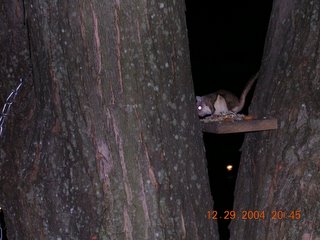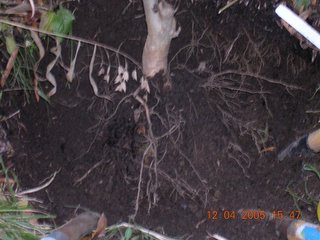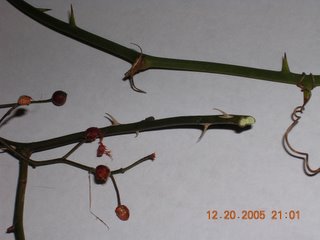Wednesday, December 28, 2005
Thursday, December 22, 2005
Wednesday, December 21, 2005
Tuesday, December 20, 2005
Monday, December 12, 2005
Sunday, December 11, 2005
Winter ID - Invasives
One area of our park was subject to a blow-down of mainly tulip and cherry trees during Hurricane Isabel in 2003. The cleared area is growing back with tree of heaven Ailanthus as the overstory tree, bush honeysuckle and multiflora rose as the understory and english ivy as the ground cover. These are all very nasty and I have been working at cutting the existing growth. Regrowth may be sprayed.
Note the large leaf scar on tree of heaven, and the smooth bark. The soft wood is extremely brittle and can be easily broken off or even pulled out of the ground. The best ID characteristic however is the smell. Scratch a bit of the bark with your fingernail, or rub a leaf between your fingers. Yech!

One area of our park was subject to a blow-down of mainly tulip and cherry trees during Hurricane Isabel in 2003. The cleared area is growing back with tree of heaven Ailanthus as the overstory tree, bush honeysuckle and multiflora rose as the understory and english ivy as the ground cover. These are all very nasty and I have been working at cutting the existing growth. Regrowth may be sprayed.
Note the large leaf scar on tree of heaven, and the smooth bark. The soft wood is extremely brittle and can be easily broken off or even pulled out of the ground. The best ID characteristic however is the smell. Scratch a bit of the bark with your fingernail, or rub a leaf between your fingers. Yech!

Thursday, December 08, 2005
Wednesday, December 07, 2005
Habitat Visitor Redux
This guy has not been around this year and so I am sad : ( .
He disappeared from our backyard wildlife habitat after we went on vacation around the end of March. Do you feed southern flying squirrels all year? Am considering peanut butter or dog food as bait to attract others. Currently I'm putting out sunflower seeds and almonds, he really liked the almonds.

This guy has not been around this year and so I am sad : ( .
He disappeared from our backyard wildlife habitat after we went on vacation around the end of March. Do you feed southern flying squirrels all year? Am considering peanut butter or dog food as bait to attract others. Currently I'm putting out sunflower seeds and almonds, he really liked the almonds.

Monday, December 05, 2005
Transplanting a Tree Three
Please forgive the poor photos. But you get the idea(s):
-Most of the roots are lost - this is a 6' tree!
-The tree is essentially moved bare-root, as I was not able to dig it out intact.
I can hardly wait until spring, to see if this thing survived. I will be sure to water it frequently.



Please forgive the poor photos. But you get the idea(s):
-Most of the roots are lost - this is a 6' tree!
-The tree is essentially moved bare-root, as I was not able to dig it out intact.
I can hardly wait until spring, to see if this thing survived. I will be sure to water it frequently.
















